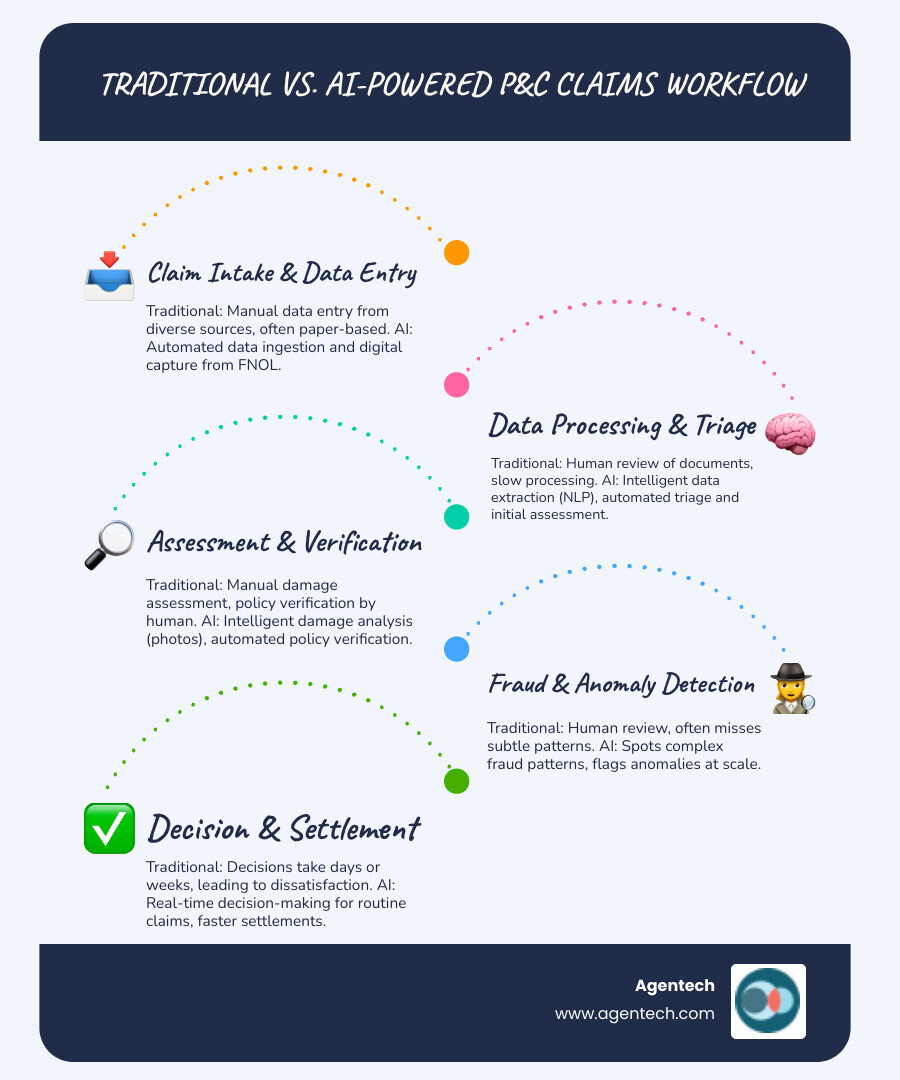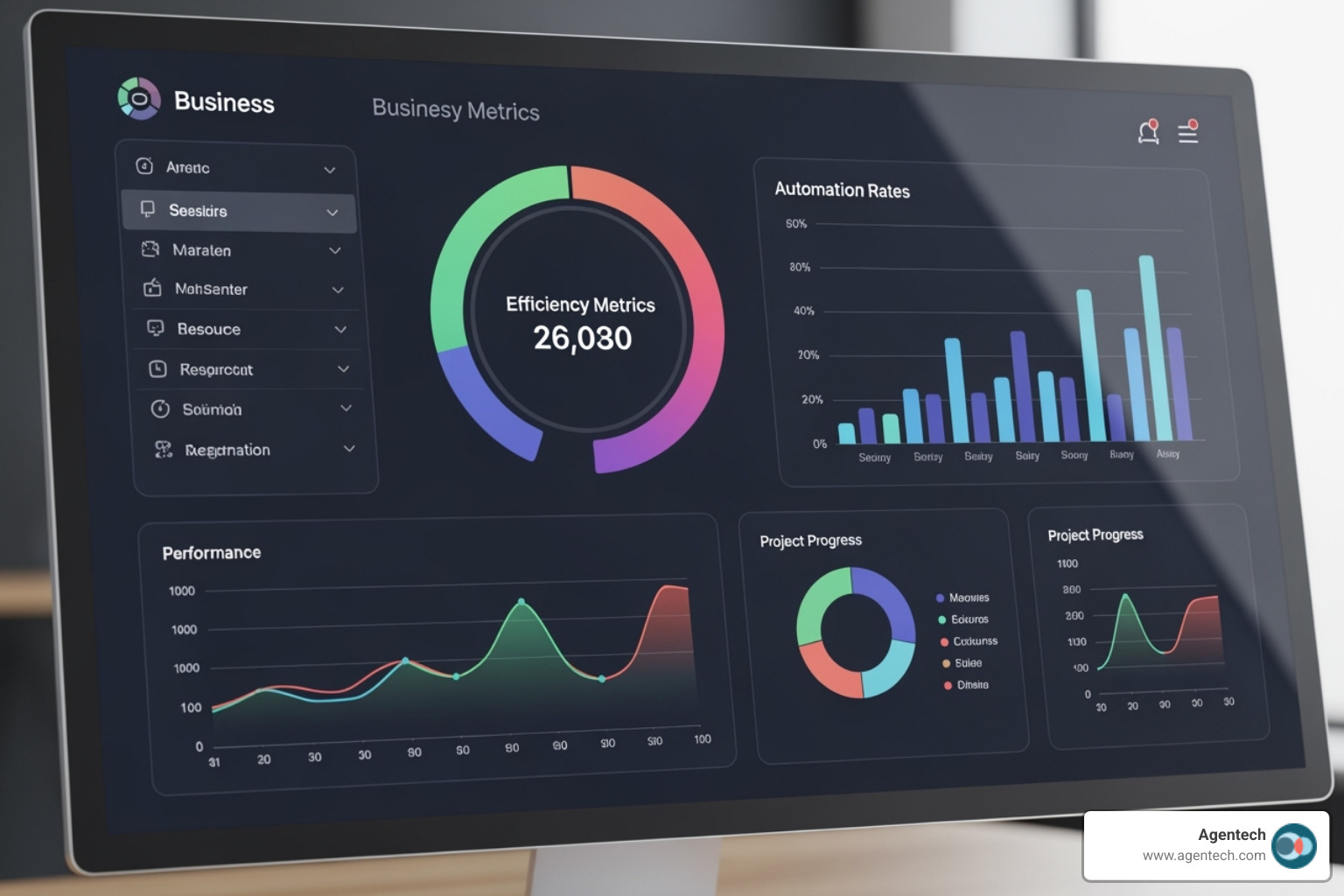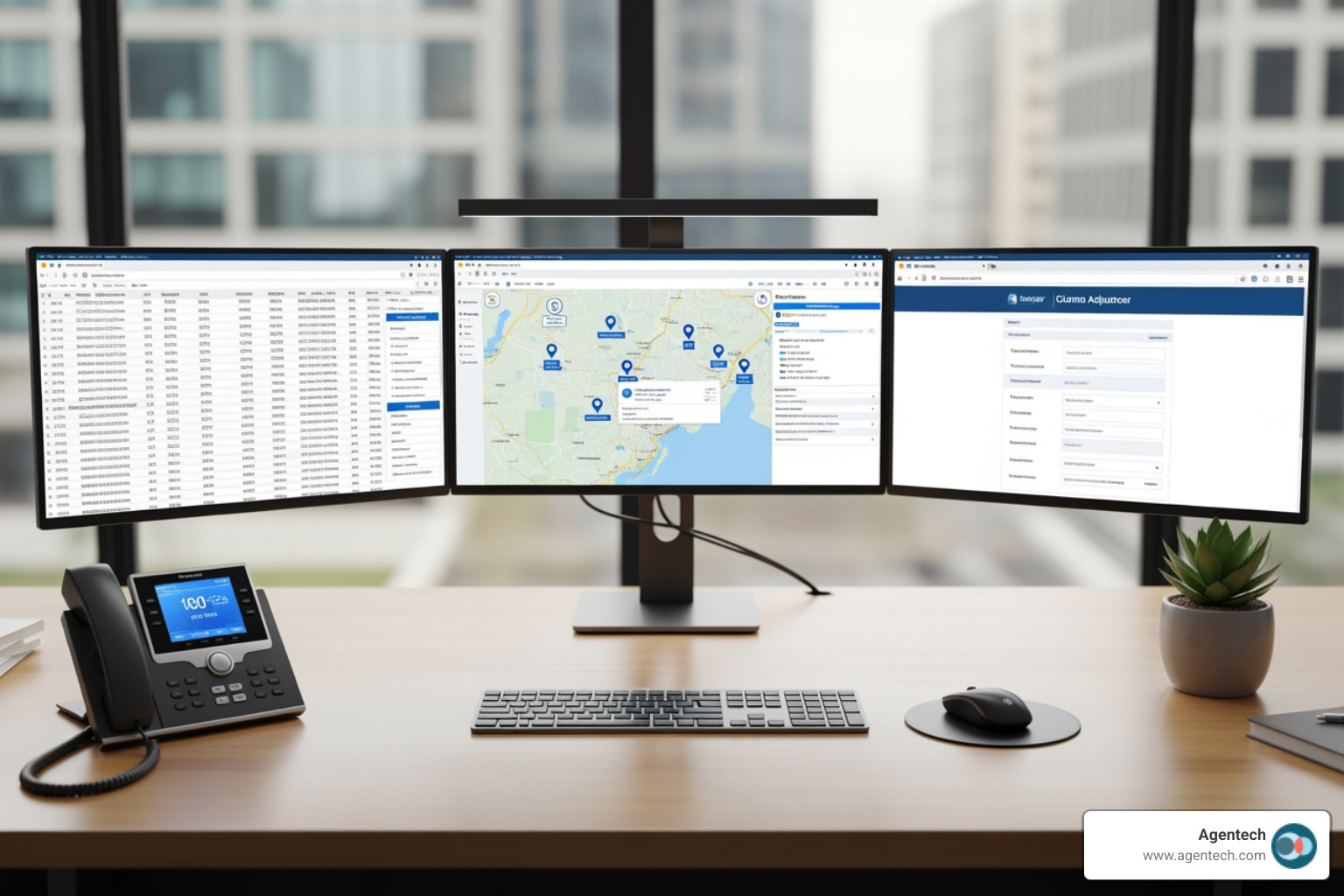The Tipping Point for P&C Claims
How is AI changing the insurance claims process is no longer a future question. It's happening now across property and casualty insurance. AI transforms P&C claims by:
- Automating data extraction from photos and documents
- Analyzing damage in minutes, not days
- Detecting fraud patterns humans can miss
- Enabling real time decisions for routine claims
- Predicting claim complexity and outcomes
The numbers tell the story. Claims handlers spend about 30% of their time on low value work. Meanwhile, 31% of policyholders are dissatisfied with their claims experience, with 60% citing settlement speed as the main issue.
Traditional automation falls short. Only 7% of claims achieve straight through processing because most claims data is unstructured, such as photos, reports, and policy documents that basic systems cannot handle.
AI is different. It understands and analyzes this unstructured data. For example, a large US travel insurer handling 400,000 claims per year cut processing time from weeks to minutes, achieving 57% automation with AI. Similarly, fraud detection systems powered by AI are saving insurers millions of dollars by flagging irregularities that would otherwise go unnoticed.
I'm Alex Pezold, founder of Agentech AI. We're building the AI workforce for P&C insurance, revolutionizing how is AI changing the insurance claims process starting with pet insurance and expanding across P&C lines. My experience scaling and exiting a successful tech company taught me that lasting change requires both innovation and practical implementation that works with existing systems.

How AI is Changing the P&C Insurance Claims Process
P&C insurance is drowning in data. Auto claims involve photos and police reports. Property claims have inspection reports and contractor bids. Workers' compensation includes medical records and incident reports. Most of this valuable information is locked in unstructured formats that traditional systems can't process. How is AI changing the insurance claims process? By making sense of this messy, real-world data.
AI doesn't just digitize information; it understands it. This shifts claims handling from reactive to proactive. We are moving from manual reviews to automated triage that identifies which claims need immediate attention and which can be fast tracked. The change touches every stage, from the First Notice of Loss (FNOL) to final settlement, reshaping how P&C carriers, TPAs, and adjusting firms operate. The Future of Insurance: How AI is Changing the Game
Beyond OCR: Solving the Unstructured Data Challenge
Traditional automation based on rules struggles with real claims data, like handwritten statements, photos from phones, and complex reports. These systems can handle structured data like policy numbers but fail with anything requiring understanding. This is why most insurers see only a 7% straight through processing rate, leaving 93% of claims in manual review queues.
AI changes this by understanding context. Natural Language Processing (NLP) reads a veterinary report and identifies the injury and its typical costs. Computer vision recognizes a damaged car's make and model, estimates repair complexity, and flags fraud indicators. For example, one Nordic insurer automated its unstructured data processing and achieved 70% accuracy in extracting and interpreting complex documents. This frees experienced adjusters to focus on cases needing human judgment. We Made AI Do the Most Tedious, Time-Consuming Task in Claims Processing: Creating the Claim Profile
The Three Layers of AI: Predictive, Generative, and Agentic
Understanding how is AI changing the insurance claims process means recognizing its three layers.
Predictive AI is the foundation. It uses historical data to forecast future events, like flagging a workers' compensation claim as potentially complex or estimating a settlement range for an auto claim.
Generative AI builds on predictions to create new content. It can summarize medical records, draft personalized policyholder communications, or generate detailed assessment reports.
Agentic AI is the cutting edge, where AI takes action. These systems act as digital coworkers, handling entire workflows. An agentic AI can receive a pet insurance claim, verify policy details, review vet bills, and approve payment without human intervention. This evolution from prediction to action creates entirely new ways of working. Agentic AI Definition
How AI is changing the P&C insurance claims process for specific tasks
AI excels at specific, everyday adjuster tasks. Intelligent data extraction instantly finds and organizes information from any document. Automated damage assessment analyzes photos of a damaged vehicle to estimate repair costs, often matching human assessors with high accuracy.
Policy verification and coverage analysis is also automated. AI reads policy language, understands limits and exclusions, and determines what is covered. Settlement recommendations are generated by analyzing all relevant factors, from damage assessments to historical settlements, ensuring fair and consistent outcomes.
AI's fraud detection capabilities are particularly powerful. It spots patterns humans miss, like reused photos or damage inconsistent with the reported incident. AI handles the routine analysis, but experienced adjusters make the final decisions on complex cases, keeping the essential human element in the loop. AI Claims Processing System
Citations:
- Agentech. "The Future of Insurance: How AI is Changing the Game"
- Agentech. "We Made AI Do the Most Tedious, Time-Consuming Task in Claims Processing: Creating the Claim Profile"
- Agentech. "Agentic AI Definition"
- Agentech. "Changing Insurance Claims: The Evolution from Generative AI to Agentic AI"
- Agentech. "AI Claims Processing System"
The Measurable Benefits for P&C Insurers, TPAs, and Adjusters
The shift to AI in claims processing is a strategic move with clear benefits for P&C insurers, Third Party Administrators (TPAs), and Independent Adjusting (IA) Firms. AI delivers measurable improvements to the bottom line, boosts efficiency, and improves customer satisfaction, creating a sustainable competitive advantage. AI Claims Processing Insurance

Slashing Cycle Times and Boosting Operational Efficiency
One of the most immediate benefits of AI in P&C claims is the dramatic acceleration of cycle times. A travel insurer based in the US handling 400,000 claims annually cut its processing time from weeks to minutes, achieving a 57% automation rate. Overall, AI can reduce claims processing costs by up to 20% and speed up the process by as much as 50%.
With AI handling repetitive tasks that consume about 30% of their time, adjusters can focus on complex cases, customer interactions, and strategic decisions. This increased throughput means more claims are processed faster with fewer errors. For simple claims, a fully automated process can enable real time resolution for up to 70% of cases, cutting operational costs by 30% to 50% and improving customer satisfaction. This helps solve the insurance labor crisis by empowering the workforce with innovation driven by AI. Solving the Insurance Labor Crisis with AI-Driven Innovation
Enhancing Accuracy, Fraud Detection, and Recovery Opportunities
AI's analytical power brings new precision to claims processing.
Claims Accuracy: AI ensures consistent and objective evaluations by analyzing vast amounts of data, including policy documents and historical claims. This minimizes human error, leads to fairer settlements, and builds trust with policyholders.
Fraud Detection: AI offers a powerful defense against fraudulent claims. It uses machine learning to analyze patterns and spot anomalies that human reviewers might miss. For example, AI can flag unusual claim patterns, detect inconsistencies in submitted information, and identify photo reuse across multiple claims. Some AI platforms have generated thousands of alerts for potential irregularities in their first year, creating a fraud savings pipeline worth millions.
Recovery Opportunities: AI is also skilled at uncovering recovery opportunities, such as in subrogation cases where a third party is responsible for a loss. AI models can analyze complex claims data to identify liability scenarios that might be overlooked during manual reviews, directly improving an insurer's loss ratio. Insurance Claims Machine Learning
| Feature | Manual Fraud Review | AI Fraud Detection |
|---|---|---|
| Speed | Slow, dependent on humans, can take days or weeks | Near instant, real time analysis |
| Scale | Limited by human capacity, difficult with large volumes | Processes vast datasets simultaneously, scales infinitely |
| Accuracy | Prone to human error, misses subtle patterns | Identifies complex patterns and anomalies across data |
| Cost | High labor costs | Lower operational costs, higher ROI |
| Proactive/Reactive | Often reactive, after a claim is filed | Proactive, identifies risks before or during processing |
Revolutionizing the Policyholder Claims Experience
In the competitive P&C insurance market, customer experience is crucial. 31% of policyholders who made claims were dissatisfied, with 60% citing settlement speed as their main concern. AI directly addresses this pain point.
- Speed of Settlement: By accelerating claims processing, AI improves settlement speed, which is directly linked to higher customer satisfaction and loyalty.
- 24/7 Service: Virtual assistants powered by AI provide round the clock support, answering questions and offering status updates whenever customers need them. Virtual AI Assistants for Insurance: Meet Your New Best Friend
- Personalized Communication: Generative AI crafts customized, empathetic communications, keeping policyholders informed through their preferred channels.
- Transparency: Systems driven by AI offer policyholders greater visibility into their claim status, building confidence and reducing inquiries.
- Improved Net Promoter Score (NPS): Faster, more accurate, and transparent claims processing leads to higher NPS scores. Close to 90% of P&C insurance customers say that claims processing efficiency influences their loyalty.
A Practical Guide to Implementing AI in Claims Operations
Implementing AI in P&C claims operations is a significant business change. For P&C insurance carriers, TPAs, and IA Firms, a successful rollout requires a holistic approach that considers your implementation strategy, technology stack, people and processes, and change management.

Strategy: Focusing on High Impact, Near Term Value
Many insurers get stuck in "pilot purgatory," testing small projects without achieving a major impact. Instead, focus on key areas in claims processing that will deliver a real, near term return. Consider automating initial claim intake for pet insurance or accelerating damage assessment for auto claims.
The goal is to set ambitious targets and work toward tangible results. Top-performing AI companies in insurance have seen much higher returns by making smart choices to drive business growth. Our hybrid AI solutions help you do just that, offering out of the box efficiency with custom quality assurance for immediate impact. A Hybrid AI Solution for Claims Automation: How Agentech Combines Out-of-the-Box Efficiency with Custom QA Precision
A good rule for allocating effort is: 10% for AI programs, 20% for technology and data, and 70% for the human side—your people and processes.
Technology: The Human in the Loop Approach
At Agentech, we believe in an approach that keeps a human in the loop. AI is here to augment adjusters, not replace them. Our AI solutions act as digital coworkers, handling routine, data heavy tasks while leaving critical decisions to your human experts.
Our technology integrates seamlessly with your existing claims management software, providing adjusters with smart insights driven by AI and recommendations. They always have the final say, ensuring that the valuable judgment and empathy of your team are improved, not replaced. Our AI is designed with adjusters in mind, giving them tools to be faster and more effective. This is the power of Agentic AI in insurance: bots become your best agents, working alongside your human team. AI Designed with Adjusters in Mind Agentic AI in Insurance: When Bots Become Your Best Agents
People and Process: Preparing Your Team for Change
The biggest challenges in AI adoption are often people-related. To succeed, you need a smart plan to prepare your team.
- Reskill the workforce: Invest in training so claims professionals can use AI tools effectively and ethically.
- Reimagine workflows: Find new, better ways to work by determining which tasks AI can automate and how human and AI tasks can flow together.
- Build AI literacy: Ensure everyone, from leaders to claims handlers, understands what AI can and cannot do to build trust.
- Foster collaboration: Encourage claims, underwriting, and IT departments to work together to define business needs and build useful tools.
- Manage the change: Clear communication, strong leadership support, and openly addressing concerns are vital. For example, Odie Pet Insurance successfully implemented Agentech to automate claims tasks, showing that with good planning, AI can fit smoothly into daily work. Odie Pet Insurance Implements Agentech to Automate Claims Tasking This is how AI is changing the insurance claims process from the inside out.
Citations:
- Boston Consulting Group. "How Insurers Can Boost Their Strategy with AI."
- McKinsey & Company. "The future of AI in the insurance industry."
- Agentech. "A Hybrid AI Solution for Claims Automation: How Agentech Combines Out-of-the-Box Efficiency with Custom QA Precision."
- Agentech. "AI Designed with Adjusters in Mind."
- Agentech. "Agentic AI in Insurance: When Bots Become Your Best Agents."
- Agentech. "Odie Pet Insurance Implements Agentech to Automate Claims Tasking."
Frequently Asked Questions about AI in Claims Processing
Will AI replace claims adjusters and other professionals?
No. The goal of how is AI changing the insurance claims process is to make adjusters more powerful, not obsolete. AI is brilliant at data analysis and repetitive tasks, but human expertise is irreplaceable for negotiating complex settlements, investigating unusual scenarios, and providing empathetic customer service.
Claims professionals spend about 30% of their time on low value work. AI takes over these tasks, freeing adjusters to focus on high value activities: complex problem-solving, relationship building, and nuanced decisions. Roles will evolve. Adjusters will become strategic orchestrators of workflows driven by AI, handling sensitive cases and providing the human touch that technology cannot replicate.
What are the ethical issues of using AI in P&C insurance claims?
Implementing AI in Property & Casualty insurance comes with ethical responsibilities we take seriously. Key concerns include:
- Data privacy: We must ensure robust data security and strict compliance with regulations like GDPR to protect sensitive policyholder information.
- Bias in AI systems: If historical data contains biases, AI can amplify them. We focus on identifying and mitigating AI bias through careful data curation and continuous monitoring to ensure fairness.
- Algorithmic transparency: When AI influences claim decisions, we need to understand its reasoning. Black box systems are problematic; adjusters and policyholders deserve clear, auditable explanations.
- Regulatory compliance: The insurance industry is highly regulated. Staying compliant with existing and emerging guidelines specific to AI is essential for maintaining the integrity of the P&C insurance system.
How does AI help detect fraud and errors in the P&C insurance claims process today?
AI's fraud detection capabilities are making a real difference for P&C insurers. The key is its ability to analyze massive datasets at superhuman speed to spot patterns that would otherwise go unnoticed.
Pattern recognition is where AI excels. It learns from historical data, including known fraudulent cases, to identify subtle red flags and connections between seemingly unrelated claims.
Anomaly detection flags claims that deviate from normal patterns, such as a property claim with unusually high repair costs for minor damage. It's like having a detective that never sleeps.
AI can cross-reference claims against millions of historical records in seconds and integrate external data like weather patterns or public records to verify claim information. This also helps reduce false positives, allowing human investigators to focus on genuinely suspicious cases. The results are immediate and measurable, showing how is AI changing the insurance claims process in the fight against fraud.
Conclusion: Building the Claims Department of the Future
The answer to how is AI changing the insurance claims process is clear: it is completely reshaping the entire journey. We are witnessing a fundamental overhaul, leading to claims being handled with incredible speed, accuracy, and efficiency. For P&C insurance carriers, TPAs, and IA Firms, this is a strategic imperative for staying competitive.
AI takes over tedious administrative tasks, freeing your adjusters to focus on the human side of their work: empathy, complex problem-solving, and building stronger relationships with policyholders. It's about letting humans be human while AI handles the heavy data lifting.
The benefits are measurable: faster cycle times, happier customers, significant cost savings, and better fraud prevention. These advantages directly impact your profitability and reputation.
At Agentech, we are proud to lead this change by building the AI workforce for the P&C insurance industry. Our solutions integrate into your existing claims management software, augmenting your human teams with intelligent automation. We believe the claims department of the future is a partnership between human expertise and advanced AI, delivering outstanding results for both insurers and policyholders.
Ready to see the future of claims in action?
Learn how Agentech can transform your claims operations
Citations:
- Accenture. "How to use AI in the insurance value chain: claims management."
- Accenture. "Improved claims experience for policyholders. An industry report found that 31% of policyholders who made recent claims were dissatisfied with their experiences, with 60% citing settlement speed as a cause of their dissatisfaction." https://newsroom.accenture.com/news/2022/poor-claims-experiences-could-put-up-to-170b-of-global-insurance-premiums-at-risk-by-2027-according-to-new-accenture-research
- Boston Consulting Group. "How Insurers Can Boost Their Strategy with AI." https://web-assets.bcg.com/pdf-src/prod-live/how-insurers-can-boost-strategy-with-artificial-intelligence.pdf
- EY. "How a Nordic insurance company automated claims processing." https://www.ey.com/en_nl/insights/financial-services/emeia/how-a-nordic-insurance-company-automated-claims-processing
- IBM. "What Is AI Bias?." https://www.ibm.com/think/topics/ai-bias
- McKinsey & Company. "The future of AI in the insurance industry."
- AutoInsurance.com. "What to Know About AI Insurance Claims."
- Forbes. "Close to 90% of insurance customers say that claims processing efficiency influences their loyalty to their insurer." https://www.forbes.com/sites/forbestechcouncil/2023/04/17/using-the-power-of-ai-in-the-insurance-sector/?sh=26bb7672335d
- Washington Post. "Some insurance companies pull out of La., Fla. in hurricane season." https://www.washingtonpost.com/business/economy/some-insurance-companies-pull-out-of-la-fla-in-hurricane-season/2022/07/01/453568ca-f8b6-11ec-86b7-30968eda178a_story.html
- WESH.com. "Florida insurance bankruptcy." https://www.wesh.com/article/florida-insurance-bankruptcy/40044775
- CBS News Colorado. "Insurers scaling back coverage in Colorado due to wildfires, hail storms." https://www.cbsnews.com/colorado/news/insurers-scaling-back-coverage-colorado-due-wildfires-hail-storms/
- ABI. "Fraudulent claims cost insurers billions annually." https://www.abi.org.uk/news/news-articles/2024/9/no-let-up-in-crack-down-on-insurance-cheats-as-industry-detects-1-billion-worth-of-fraudulent-claims/




